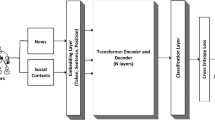Abstract
Over the last few decades, the expansion of technology and the internet has led to the number of users proliferating on social media, with a simultaneous increase in hate speech. A critical concern is, hate speech is not only responsible for igniting violence and spreading hatred, but its detection also requires a considerable amount of computing resources and content monitoring by human experts and algorithms. While the research is an active area, and several artificial intelligence techniques have been proposed in the past to address the concern, the rise in the number of petabytes of the content generated calls for methods that will exhibit improved performance and reduced model development time. We propose a transfer learning approach for detecting hate and offensive speech on social media that deploys a pre-trained model for data analysis thereby promoting model reusability. We propose two transfer learning models, i.e. Google’s Word2vec model using LSTM and GloVe Model using LSTM for the same and compare the performance of our proposed model against unigram and bigram language models for Naive Bayes (NB), Decision Trees (DT), and Support Vector Machines (SVM), which are also the baseline algorithms considered for analysis. The performance of the proposed models for classifying hate speech, offensive speech, and neutral speech is validated using metrics such as precision, recall, F-1 score, and support. The overall performance of the models across multiple datasets has been evaluated with respect to accuracy. In-depth experimental analysis and results depict that the proposed model is significantly robust for detecting hateful and offensive speech and also performs better than the considered baseline algorithms.


















Similar content being viewed by others
Data availability
Not Applicable.
References
Al-Hassan A, Al-Dossari H (2021) Detection of hate speech in Arabic tweets using deep learning. Multimedia Systems:1–12
Al-Makhadmeh Z, Tolba A (2020) Automatic hate speech detection using killer natural language processing optimizing ensemble deep learning approach. Computing 102(2):501–522
Aulia N, Budi I (2019) Hate speech detection on Indonesian long text documents using machine learning approach. In: Proceedings of the 2019 5th international conference on computing and artificial intelligence, pp 164–169
Ayo FE, Folorunso O, Ibharalu FT, Osinuga IA (2020) Machine learning techniques for hate speech classification of twitter data: state-of-the-art, future challenges and research directions. Comput Sci Rev 38:100311
Aziz NAA, Maarof MA, Zainal A (2021) Hate speech and offensive language detection: a new feature set with filter-embedded combining feature selection. In: 2021 3rd international cyber resilience conference (CRC). IEEE, pp 1–6
Briliani A, Irawan B, Setianingsih C (2019) Hate speech detection in Indonesian language on Instagram comment section using K-nearest neighbor classification method. In: 2019 IEEE international conference on internet of things and intelligence system (IoTaIS). IEEE, pp 98–104
Dataset 1, Hate Speech and Offensive Language Dataset, https://www.kaggle.com/mrmorj/hate-speech-and-offensive-language-dataset
Dataset 2, Hate-Offensive Speech Detection, https://www.kaggle.com/alternacx/hateoffensive-speech-detection
Gambäck B, Sikdar UK (2017) Using convolutional neural networks to classify hate-speech. In: Proceedings of the first workshop on abusive language online, pp 85–90
García-Díaz JA, Jiménez-Zafra SM, García-Cumbreras MA, Valencia-García R (2022) Evaluating feature combination strategies for hate-speech detection in spanish using linguistic features and transformers. Complex Intell Syst:1–22
Gencoglu O (2020) Cyberbullying detection with fairness constraints. IEEE Internet Comput
Jha S, Kumar R, Abdel-Basset M, Priyadarshini I, Sharma R, Long HV (2019) Deep learning approach for software maintainability metrics prediction. Ieee Access 7:61840–61855
Khan H, Yu F, Sinha A, Gokhale SS (2021) A parsimonious and practical approach to detecting offensive speech. In: 2021 international conference on computing, communication, and intelligent systems (ICCCIS). IEEE, pp 688–695
Kumar D, Kumar N, Mishra S (2021) QUARC: quaternion multi-modal fusion architecture for hate speech classification. In: 2021 IEEE international conference on big data and smart computing (BigComp). IEEE, pp 346–349
Le Q, Mikolov T (2014) Distributed representations of sentences and documents. In: International conference on machine learning. PMLR, pp 1188–1196
Matamoros-Fernández A, Farkas J (2021) Racism, hate speech, and social media: a systematic review and critique. Telev New Media 22(2):205–224
Miok K, Škrlj B, Zaharie D, Robnik-Šikonja M (2021) To ban or not to ban: Bayesian attention networks for reliable hate speech detection. Cogn Comput:1–19
Mishra S, Prasad S, Mishra S (2021) Exploring multi-task multi-lingual learning of transformer models for hate speech and offensive speech identification in social media. SN Comput Sci 2(2):1–19
Muhammad IZ, Nasrun M, Setianingsih C (2020) Hate speech detection using global vector and deep belief network algorithm. In: 2020 1st international conference on big data analytics and practices (IBDAP). IEEE, pp 1–6
Oriola O, Kotzé E (2020) Evaluating machine learning techniques for detecting offensive and hate speech in south African tweets. IEEE Access 8:21496–21509
Pennington J, Socher R, Manning CD (2014) GloVe: global vectors for word representation
Pitsilis GK, Ramampiaro H, Langseth H (2018) Effective hate-speech detection in twitter data using recurrent neural networks. Appl Intell 48(12):4730–4742
Pritam N, Khari M, Kumar R, Jha S, Priyadarshini I, Abdel-Basset M, Long HV (2019) Assessment of code smell for predicting class change proneness using machine learning. IEEE Access 7:37414–37425
Priyadarshini I, Cotton C (2019) Internet memes: a novel approach to distinguish humans and bots for authentication. In: Proceedings of the future technologies conference. Springer, Cham, pp 204–222
Priyadarshini I, Cotton C (2020) Intelligence in cyberspace: the road to cyber singularity. J Exp Theor Artif Intell:1–35
Priyadarshini I, Cotton C (2021) A novel LSTM–CNN–grid search-based deep neural network for sentiment analysis. J Supercomput:1–22
Priyadarshini I, Puri V (2021a) A convolutional neural network (CNN) based ensemble model for exoplanet detection. Earth Sci Inf 14(2):735–747
Priyadarshini I, Puri V (2021b) Mars weather data analysis using machine learning techniques. Earth science informatics. Springer
Priyadarshini I, Wang H, Cotton C (2019) Some cyberpsychology techniques to distinguish humans and bots for authentication. In: Proceedings of the future technologies conference. Springer, Cham, pp 306–323
Priyadarshini I, Kumar R, Sharma R, Singh PK, Satapathy SC (2021a) Identifying cyber insecurities in trustworthy space and energy sector for smart grids. Comput Electr Eng 93:107204
Priyadarshini I, Mohanty P, Kumar R, Sharma R, Puri V, Singh PK (2021b) A study on the sentiments and psychology of twitter users during COVID-19 lockdown period. Multimed Tools Appl:1–23
Pronoza E, Panicheva P, Koltsova O, Rosso P (2021) Detecting ethnicity-targeted hate speech in Russian social media texts. Inf Process Manag 58(6):102674
Roy PK, Bhawal S, Subalalitha CN (2022) Hate speech and offensive language detection in Dravidian languages using deep ensemble framework. Comput Speech Lang 75:101386
Saeed F, Al-Sarem M, Alromema W (2021) Tuning hyper-parameters of machine learning methods for improving the detection of hate speech. In: Advances on smart and soft computing. Springer, Singapore, pp 71–78
Setyadi NA, Nasrun M, Setianingsih C (2018) Text analysis for hate speech detection using backpropagation neural network. In: 2018 international conference on control, electronics, renewable energy and communications (ICCEREC). IEEE, pp 159–165
Sohn H, Lee H (2019) Mc-bert4hate: hate speech detection using multi-channel bert for different languages and translations. In: 2019 international conference on data mining workshops (ICDMW). IEEE, pp 551–559
Tuan TA, Long HV, Kumar R, Priyadarshini I, Son NTK (2019) Performance evaluation of botnet DDoS attack detection using machine learning. Evol Intel:1–12
Vashistha N, Zubiaga A (2021) Online multilingual hate speech detection: experimenting with Hindi and English social media. Information 12(1):5
Vo T, Sharma R, Kumar R, Son LH, Pham BT, Tien Bui D … Le T (2020) Crime rate detection using social media of different crime locations and Twitter part-of-speech tagger with Brown clustering. J Intell Fuzzy Syst (Preprint):1–13
Waseem Z, Hovy D (2016) Hateful symbols or hateful people? Predictive features for hate speech detection on twitter. In: Proceedings of the NAACL student research workshop, pp 88–93
Wullach T, Adler A, Minkov EM (2020) Towards hate speech detection at large via deep generative modeling. IEEE Internet Comput
Author information
Authors and Affiliations
Corresponding author
Ethics declarations
Conflict of interest
None.
Additional information
Publisher’s note
Springer Nature remains neutral with regard to jurisdictional claims in published maps and institutional affiliations.
Rights and permissions
Springer Nature or its licensor (e.g. a society or other partner) holds exclusive rights to this article under a publishing agreement with the author(s) or other rightsholder(s); author self-archiving of the accepted manuscript version of this article is solely governed by the terms of such publishing agreement and applicable law.
About this article
Cite this article
Priyadarshini, I., Sahu, S. & Kumar, R. A transfer learning approach for detecting offensive and hate speech on social media platforms. Multimed Tools Appl 82, 27473–27499 (2023). https://doi.org/10.1007/s11042-023-14481-3
Received:
Revised:
Accepted:
Published:
Issue Date:
DOI: https://doi.org/10.1007/s11042-023-14481-3




